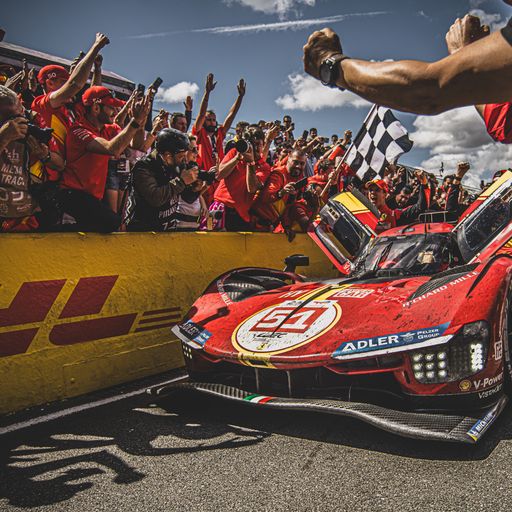Sebring and the Art of Motor Racing
By Jack Webster
Since 1950 an auto race has been held near the normally sleepy and quiet town of Sebring in
south central Florida. At what was once a World War II Army Air Force, B-17 and B-24 bomber
training base, one of the most famous endurance sports car races in the world is held every
year. In 1950 the inaugural event was a six-hour race held on New Year’s Eve. Fourteen months
later in 1952 the first 12-hour race was held and in 1953 the race became internationally known
as part of the World Sports Car Championship, attracting cars and drivers from around the
world. Every year since then, the Twelve Hours of Sebring has been held using the runways and
connecting taxiways of what was once Hendricks Army Airfield. That is, every year except 1974
when the race was cancelled due to the energy crisis – and even with no race, thousands of
sports car racing fans showed up to camp and party – just to take in the experience of being at
Sebring during spring break. Such is the allure of Sebring in the springtime.
“There are only three sports: bullfighting, motor racing, and mountaineering; the rest are
merely games.” – Ernest Hemmingway
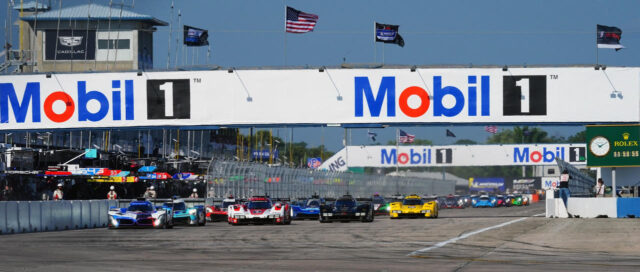
The pole winning #24 BMW GTP leads the field into Turn 1 at the start. Note the Rolex clock on the right – five seconds have passed since the drop of the green flag – 11 hours, 59 minutes and 55 seconds to go!
Certainly, there are other tracks with much better facilities, although IMSA, the current
caretakers of this national treasure, has taken great strides to make the facility more fan and
team friendly, with major investments in infrastructure such as a new pit structure, hospitality
suites, modern restrooms, showers and a new drive over bridge. For sure there are tracks that
are much smoother, but Sebring has become world famous for its original cracks and bumps
that have been there since B-17 and B-24 bombers thundered down its runways. “Respect the
Bumps” has become the official slogan of the circuit, for mastering and winning at Sebring
requires it. Frankly, if the place was to ever be resurfaced, covering those original runways and
taking out those famous bumps, Sebring would lose all of its charm, its reason for being, its
essence. In addition to “Respect the Bumps”, one must respect the history.
“A win here lasts forever.” – Dan Gurney, 1959 Sebring winner
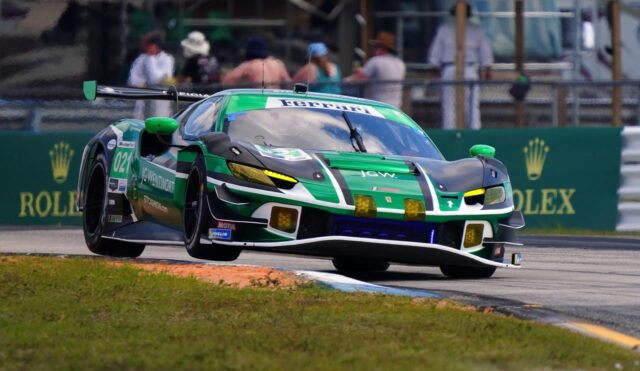
Not respecting the bumps – the #021 Triarsi Competizione Ferrari 296 GT3 jumps the curbs in the Esses at Sebring.
Think of some of the incredible drivers who have raced and won at Sebring. Legendary drivers
John Fitch, Stirling Moss, Juan Manuel Fangio, Mike Hawthorn, Ken Miles, Phil Hill, Dan Gurney,
John Surtees, Jim Hall, Ken Miles, Bruce McLaren, Mario Andretti, Jacky Ickx, Jo Siffert, Vic
Elford, Hurley Haywood, Peter Gregg, Brian Redman, Hans Stuck, Al Holbert, John FItzpatrick,
Bob Wollek, Jochen Mass, Bobby Rahal, Tom Kristensen and many, many more raced and won throughout the
race’s history and their achievements and exploits are permanently etched in the concrete
cracks and bumps of the runways and taxiways of the former Hendricks Army Airfield.
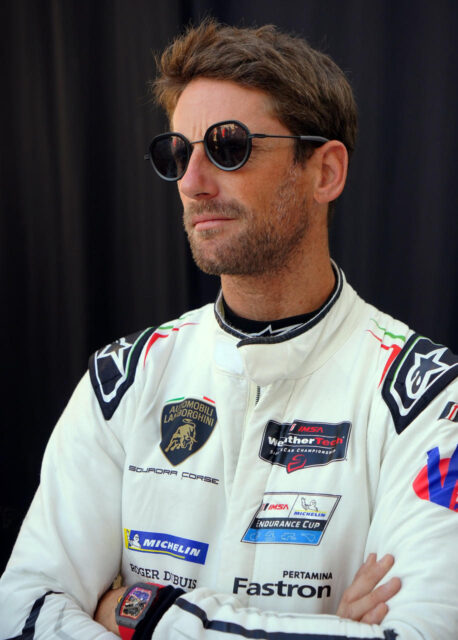
Lamborghini SC63 pilot Romain Grojean waits in the pits for his turn behind the wheel.
It still gives me goosebumps every year when I stand in the pits at Sebring, look out onto
the main straight and realize and appreciate the fact that the pit surface I am standing on and
the main straightaway I am looking at, are the very same track surface that Juan Manuel Fangio
and Jean Behra used on their way to victory in 1957, piloting the factory Maserati 450S, while
Stirling Moss and Harry Schell finished second in the second factory Maserati. Every year taking
in the sights and smells of Sebring feels like time travel, like I am in a ‘Tesseract’ as in the movie
‘Interstellar’ – observing all of the history and events of the place simultaneously. Such is the
special nature of Sebring.
Mario Andretti won Sebring three times, including the race that many consider to be the
greatest Sebring Twelve Hours ever – the 1970 race where Mario took the checkered flag for
Ferrari ahead of the Porsche 908 of Peter Revson and Steve McQueen (yes, that Steve
McQueen). In the modern era, historic achievements by the likes of Tom Kristensen (6 wins), Dindo Capello
(5 wins), Frank Biela (4 wins), and Allan McNish (4 wins), are celebrated by those who
remember the record number of consecutive Audi victories beginning at the turn of the 21st century.
“Sebring is a big event and a real challenge for man and machine. Apart from the bumps,
there are five different types of tarmac…Sebring is stressful for the drivers and cars.”
– Tom Kristensen, 6-time Sebring winner
Time marches on and new legends are currently being made on the runways and taxiways at
Sebring International Raceway. Team owner and former driver Wayne Taylor won the race in
1996 and his sons Ricky and Jordan have followed in his footsteps as winners as well. Pipo
Derani of Brazil is already a four-time winner with his first win coming only nine years ago in
2016 (he also won in 2018, 2019 and 2023). 2025 winning Porsche drivers Nick Tandy and
Laurens Vanthoor just celebrated their first wins, while their teammate Felipe Nasr claimed his
second Sebring twelve-hour victory.

The winning Porsche Penske aggressively jumping at Turn 5 on Saturday afternoon.
Well over 3000 drivers have participated in the Twelve Hours of Sebring through the years and
the event has acted as a magnet for celebrity drivers, with a number of them participating
throughout the race’s history, with varying degrees of success. Legendary CBS newsman Walter
Cronkite raced a Lancia there in 1959. Astronaut and moonwalker Pete Conrad piloted a
Porsche in the 1971 race, Dick Smothers won his class twice (in 1969 and 1971). Paul Newman
raced at Sebring in 1977. Patrick Dempsey raced in 2013 and 2014. James Brolin, Bobby
Carradine, Lorenzo Lamas, Gene Hackman and Craig T. Nelson are all part of the history of
Sebring as drivers. Of course, the most famous of the celebrity drivers was Steve McQueen who
famously finished 2nd overall – with his foot in a cast no less – behind Mario Andretti, in a Porsche 908 in the 1970 race, but few know that he also piloted an Austin Healey Sprite in the 1962 race.
“Respect the bumps. If you can run 12 hours at Sebring, you can run 24 hours anywhere else.”
– Doug Fehan, Corvette Racing
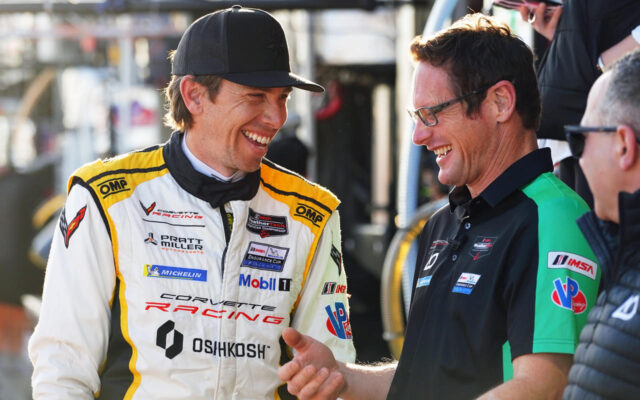
Corvette driver Tommy Milner and AO Racing team principal Gunnar Jeannette share a laugh before the start of the race. AO would go on to win the GTD-PRO class for Porsche with ‘Rexy’.
Teams and manufacturers who want to win that other famous endurance sports car race – the
24-hour contest held at Le Mans in France – come to Sebring to test their new cars. The saying
goes that if you can survive 12 hours at Sebring, you can more easily survive 24 hours at Le
Mans. Sebring will properly test the limits of your drivers and their machines. Manufacturers know
this, and the list of manufacturers who have scored overall wins at Sebring is impressive. Porsche
leads with 19 wins (as of the 2025 race won by Porsche Penske with the 963), followed by Ferrari with 12,
Audi with 11, Nissan and Cadillac with 5 each and Ford with 4.
In a world filled with cookie cutter FIA and F1 spec tracks with massive asphalt run off areas,
huge debris fences at every corner and fans removed from the track action and not allowed in
the paddock, Sebring and tracks like it in the US (personal favorites like Watkins Glen and Road
America come to mind), it is no wonder that Sebring is a favored destination by both drivers
and fans alike. Drivers constantly state that they like the challenge of racing at Sebring and the
fact that if you make an error, there are consequences for those errors. In many ways, Sebring
requires that a driver raise the level of his game to match the challenges of the track. Make a
mistake here, and your race can be over quickly (look no further than 4-time winner Pipo
Derani who crashed out while leading the 2024 race). One miscue, one slight mistake and your
day will likely be over.

The view from above – the AF Corse Ferrari 296 GT3 rides the curbs as it exits the Turn 7 hairpin.
Fans love the access to the teams, cars and drivers and the outstanding viewing opportunities
that surround the circuit. Perhaps that is why campers start lining up weeks ahead of time in
the field adjacent to the race track to be the first in line when they open the track for the race.
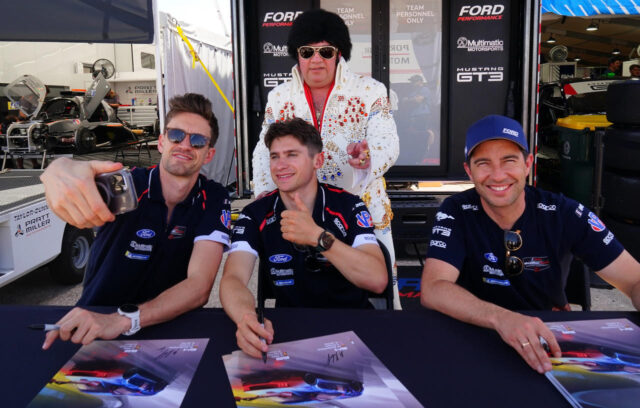
Ford Mustang pilots Ben Barker, Sebastian Priaulx and Mike Rockenfeller are joined by Elvis at the autograph session. Scenes like this are unique to Sebring, Ben takes a selfie to preserve the moment.
“I remember when we had the WEC (race) in 2019 and the drivers would tell me, they come to
Sebring and instead of being isolated from the fans and having these perfect circuits, they
come here and the fans have total access to them. And they love it. They feel the atmosphere,
it’s so different to them.” – Ken Breslauer, Sebring historian and former Media Director.
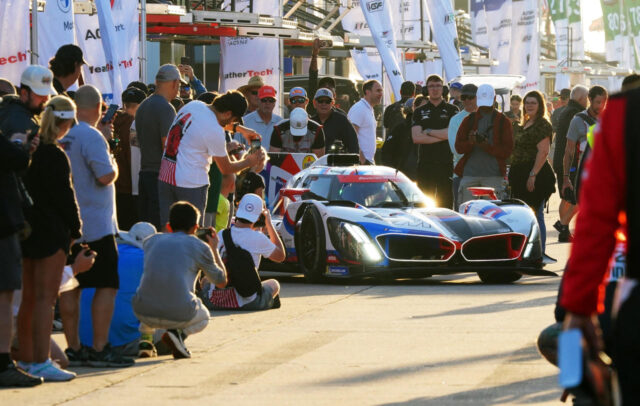
As the sun rises over the Sebring paddock, the #25 BMW GTP pulls out of its garage space to run the gauntlet of spectators and photographers on its way to the pre-grid on race day.
There are legendary encampments and legendary characters in abundance at Sebring during
the 12 Hours. Green Park in the infield is known by racers the world over, and many drivers
make the trek to that area during race week to visit and check out the goings on. Groups and
camps like Turn 10, La Bomba, F-Troop, Dodge City, Turn 4 Palm Palace,
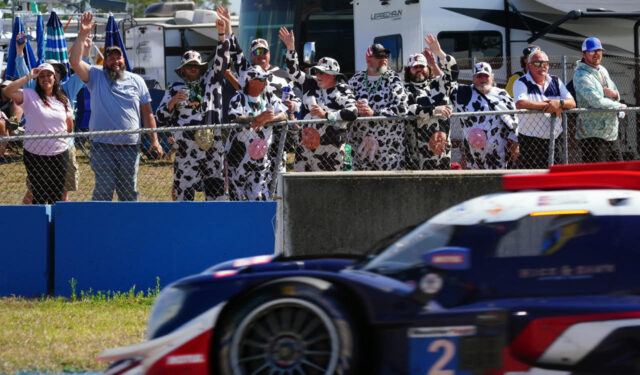
Another Sebring staple – the Sebring Cows – watching the action from iconic Turn 10 during the race.
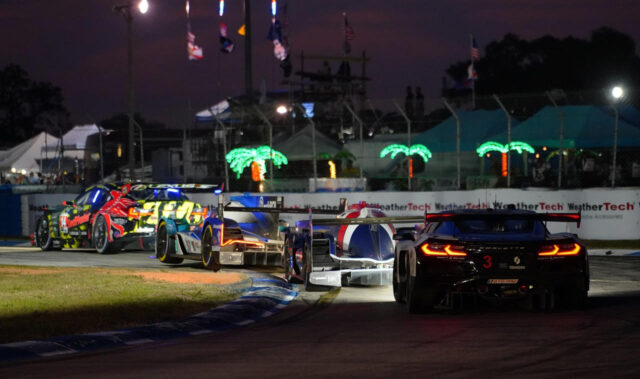
Close multi-class racing action by the lighted palm trees at Turn 4.
The Tiki Bar and Sponge Bob, to name a few, have been coming and setting up camp for years,
if not decades. Then there are the characters walking around like the Sebring Cows (guys dresses as cows,
complete with udders), who have been going to the races for over 30 years. Walk around and
you will see the Monks, the Vikings and the Romans. And don’t forget YouTube sensation and
driver favorite interviewer Kip Sebring.
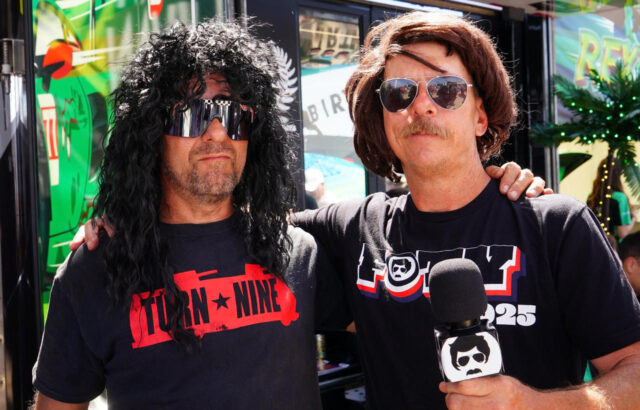
Turn 9 Sebring interviewing duo of Speed Metal and Kip Sebring making the rounds during the autograph session. Many of the drivers enjoy being interviewed by them.
To those of us who have been involved in motorsports our entire lives, auto racing is much
more than a sport. At its best, it is an art form. IMSA has done an excellent job of elevating
sports car racing in the US to a new level, likely ushering in a new “golden era” of motorsport.
If you appreciate motor racing and regard it as art, Sebring is the perfect canvas upon which to
paint the history and future of the sport. The people are the brushes, the cars are the paints,
Sebring is the canvas and fate is the artist. With a profound respect for the past, appreciation of
the present and vision for the future, I for one, hope that Sebring never loses focus of where it
came from.
Sebring – Respect the Bumps. Celebrate the history.
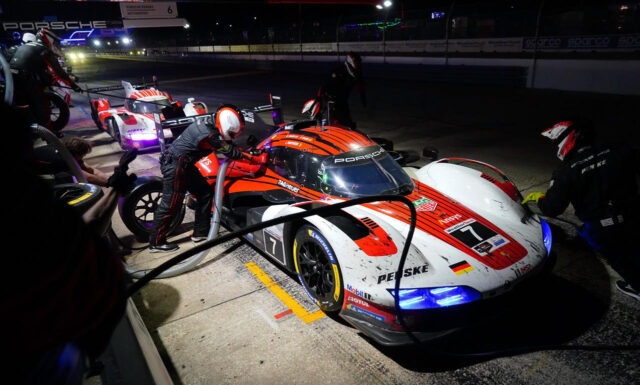
Final pit stop for Team Penske

The Whelen Cadillac in the afternoon light at Turn 11.

Reminder of Sebring’s aviation history, as a derelict passenger jet makes an appropriate background for the AWA Racing Corvette as it rides the curbs at Turn 16


